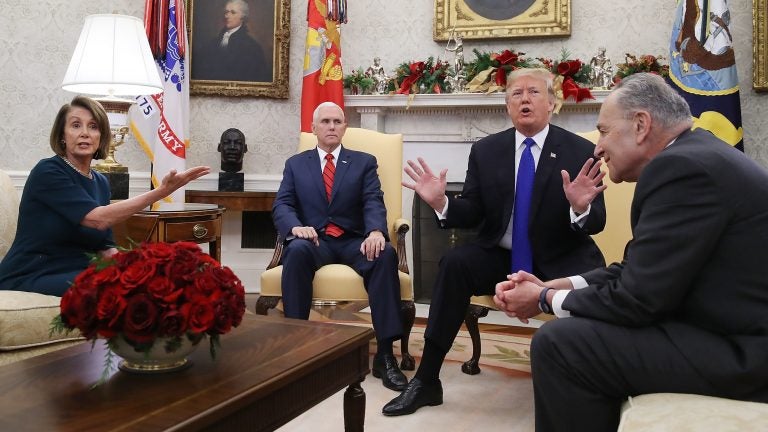In fight with ‘Chuck and Nancy,’ Trump says he’d be ‘proud’ to shut down government

With a partial government shutdown on the horizon, President Trump and Democratic leaders had a heated exchange over border security and wall funding in front of reporters. (Mark Wilson/Getty Images)
Updated 1:58 p.m. ET
In a testy Oval Office exchange with the two top congressional Democrats, Rep. Nancy Pelosi and Sen. Chuck Schumer, President Trump made clear he would be “proud” to shut down the government in less than two weeks if he doesn’t get funding for his border wall.
“I’ll be the one to shut it down. I will take the mantle. And I will shut it down for border security,” Trump told House and Senate Democratic leaders as Vice President Pence sat by stoically.
The statement from Trump came in an extraordinary show before the cameras and the press, with minutes of tense back-and-forth with both Pelosi, the likely incoming House speaker, and Schumer, the Senate minority leader.
Democratic leaders have made it clear they don’t intend to give the president a victory on funding for his signature border wall. Speaking after the meeting, both Schumer and Pelosi thought they had emerged with the upper hand after seemingly baiting Trump into taking the blame if there’s a partial shutdown just days before Christmas.
“This Trump shutdown, this temper tantrum he seems to want to throw, will not get him his wall,” the Senate minority leader told reporters outside the White House.
Throughout the meeting, Trump kept insisting that much of the wall has already been built (numerous fact checkers earlier this year determined it hasn’t, which Schumer pointed out) and he’s also said that the military can build the rest. During the 2016 campaign, Trump kept claiming that Mexico would pay to build the wall, but he has since dropped that talking point.
Pelosi insisted during the meeting that the cameras should leave, saying afterward she made such a request because “we didn’t want to contradict the president when he was putting forth figures that have no basis in fact. … I didn’t want to say in front of those people, ‘You have no idea what you’re talking about.'”
Except by making that comment just after leaving the Oval Office, Pelosi was saying just that. She also kept trying to explain to Trump that there wasn’t enough support even in the GOP-controlled House for his border wall, urging him to accept a continuous funding resolution at the current spending levels, or $1.3 billion for a year. But Trump kept interjecting to shift blame, saying a House vote wouldn’t matter since he needs to get to 60 votes in the Senate anyway and that would require help from Democrats — a frequent complaint of his.
The tense exchanges underscored the challenges in the coming two years of divided government. Trump diverted from discussing Democrats’ takeover of the House, choosing to focus on GOP gains in the Senate — thanks, in large part, to a very Republican-friendly map in the 2018 midterms.
“When the president brags that he won North Dakota and Indiana, he’s in real trouble,” Schumer jabbed.
“Well, I did,” Trump retorted.
Democratic resistance to funding the wall may have prompted President Trump’s pre-meeting tweetstorm, which over a series of five long tweets seemed to simultaneously concede defeat and declare victory on wall funding.
…..I look forward to my meeting with Chuck Schumer & Nancy Pelosi. In 2006, Democrats voted for a Wall, and they were right to do so. Today, they no longer want Border Security. They will fight it at all cost, and Nancy must get votes for Speaker. But the Wall will get built…
— Donald J. Trump (@realDonaldTrump) December 11, 2018
….People do not yet realize how much of the Wall, including really effective renovation, has already been built. If the Democrats do not give us the votes to secure our Country, the Military will build the remaining sections of the Wall. They know how important it is!
— Donald J. Trump (@realDonaldTrump) December 11, 2018
Troops have been stationed along the border since just before the midterm elections, and while some are being extended through the end of January, other units have been sent home.
“He’s talking about reprogramming/transferring funds from other [Department of Defense] programs,” said Stan Collender, a federal budget expert, when asked if he could explain the Trump tweets. “That would indeed take away resources from other activities.”
Collender said he wasn’t sure how much discretion Trump would actually have to do this and said it will “get the new Democratic House very angry.”
Even before the morning tweetstorm, in recent days Trump had been far less specific about his demands for border-wall funding than he has been in past rounds of budget talks. Sometimes he leaves out specific dollar amounts (though the standing ask is $5 billion). And his use of the phrase “border security” indicates more than just funding to build the wall.
Arizona, together with our Military and Border Patrol, is bracing for a massive surge at a NON-WALLED area. WE WILL NOT LET THEM THROUGH. Big danger. Nancy and Chuck must approve Boarder Security and the Wall!
— Donald J. Trump (@realDonaldTrump) December 7, 2018
“Congress must fully fund border security in the year-ending funding bill,” Trump said Friday in a speech at a law enforcement conference. “We have to — we have to get this done. They’re playing games. They’re playing political games. I actually think the politics of what they’re doing is very bad for them, but we’re going to very soon find out. Maybe I’m not right, but usually I’m right.”
Democrats, looking at public opinion, may feel they have some leverage in the talks. A new NPR/PBS NewsHour/Marist poll out Tuesday shows that 57 percent of Americans, including 63 percent of independents, want the president to compromise on the border wall to prevent gridlock and not risk a government shutdown. Two-thirds of Republicans, however, want the president to stand his ground. And President Trump is often laser focused on his base.
A history of failed meetings with “Chuck and Nancy”
The days of high expectations for White House summits leading to bipartisan breakthroughs were well in the past even before Tuesday’s Oval Office throw down.
A little more than a year ago, Trump had a couple of meetings with Schumer and Pelosi. He said he’d worked out a deal on immigration with “Chuck and Nancy,” as he called them.
“I think something can happen,” Trump told reporters. “We’ll see what happens. But something will happen.”
Nothing happened. The deal blew up without even an agreement on what the deal was.
Can Trump work with a Democratic House next year?
The sparring between Trump, Pelosi and Schumer may well be a preview of the next two years of divided government. Both Trump and Pelosi, who is expected to once again become speaker when Democrats take control of the House, have talked about the potential for bipartisan compromise on things like infrastructure and prescription drug prices. But they’ve also both foreshadowed conflict.
Pelosi and Democrats are promising robust investigations of Trump and his administration, and Trump has said that would lead to a “warlike posture.”
“Then at the end of two years, nothing is done,” Trump predicted. “Now what’s bad for them is being in the majority, I’m just going to blame them.”
This leaves many questions — are Democrats willing or able to compromise with Trump? Is Trump willing to deal? If he is, will congressional Republicans go along? And, given the way Trump has changed his mind in the midst of past negotiations, will anyone trust him?
Still, allies of the president and Pelosi interviewed for this story say some limited compromise is possible.
“I think there’s several positions the president has that frankly line up more traditionally with Democrats,” said Marc Short, former director of legislative affairs for the Trump administration. “The question I think that is yet to be determined is whether or not Democrats will give their leadership the flexibility to negotiate with the president.”
That’s one way of pinning blame back on the other party when big things fail to get done. Short also questioned whether Democrats would be willing to give Trump a win as he begins his re-election campaign in earnest.
John Lawrence, a former chief of staff to Pelosi, countered that Democrats are likely open and looking to cut some deals.
“[Pelosi] is going to be, and I think Democrats in the House are going to be, concerned with proving that they can be trusted that they can govern,” Lawrence said.
Short and Lawrence both see incentives for their respective parties to get something done, while questioning whether those incentives exist for the other side. But first they have to make it to next year. And the budget fight brewing as 2018 closes out could well affect the relationship going forward.
9(MDAzMzI1ODY3MDEyMzkzOTE3NjIxNDg3MQ001))




